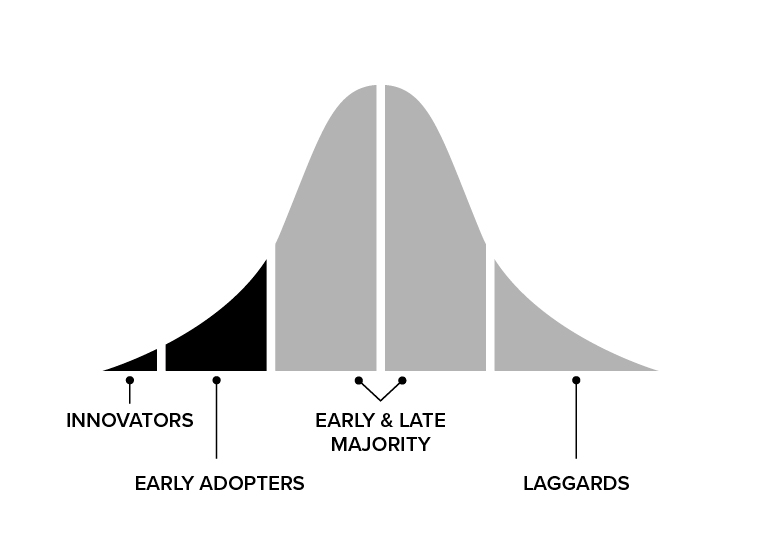In our most recent strategy blog, we talked about Kim and Mauborgne’s Blue Ocean Strategy. Today, we’d like to introduce you to a different concept to help you think of the road ahead in a different way: Seth Godin’s Purple Cow. Some of you may already be familiar with Godin’s work as the former dot com business executive has been sharing out indispensable marketing advice for nearly 30 years.
Most of Godin’s work is about helping your product stand out in an overcrowded market place through an intelligent combination of marketing, keen audience insight, but also knowing when to quit , and, most importantly, selling a product that’s actually worth talking about. This latter one is what Seth Godin calls: your company’s purple cow.
What is a Purple Cow?
According to Seth Godin, the holy grail of marketing has for a long time been about the successful application of the five Ps: Product, Price, Place, Promotion, and lately People. It’s an idea that’s been around since the early days of TV advertising but, as a quick Google search reveals, it’s still very much alive and kicking today.
Although the exact meaning of each individual P may occasionally change (for instance, speaking of Position rather than Place), the overall principle hasn’t: you create a product, put it in the right place, give it an interesting price, start promoting it, and take care of the people buying it (through, for example, after sales support).
But in an age where mass media services are increasingly fighting a war for our attention and most products that hit the shelves are but slight variations of other already existing products, Godin believes that we need a new P: a Purple Cow.

He says that because today’s consumers (including your company’s) are constantly bombarded by ads and other promotional messages, they have become exceptionally adept at ignoring most of them. They’ve stopped listening, because they’ve seen and heard it all before. Putting your product in the right place with the right price simply doesn’t cut it anymore.
In this environment, most products are basically like brown cows. At one point in time, they might have made you curious, but now you see them all the time, everywhere. There’s nothing inherently wrong with them, but they don’t stand out from the crowd either. But a purple cow, now that would get our attention. At least for a little while.
That’s the metaphor Seth uses in his book to explain why we need a Purple Cow, or put more simply: a remarkable product or service. Not because it’s new, but because it does something unique or extraordinary that helps to set it apart from all the others.
How do you recognize a Purple Cow?
Simply saying that a product needs to be remarkable might not be useful advice, so let’s break it down a little. Most companies try to cater to the masses, thinking that if they create products most people need and target their messages at as many people as they possibly can, some of them are likely to stick. But according to Seth, this thinking is inherently flawed.
While it may be true that some ads, like Google ads, may work quite well on occasion because they’re targeted at people who’ve already expressed some interest in a particular product or service, at the end of the day, most people are tired of being advertised to and will therefore ignore your messages most of the time anyway. What you should be doing instead, is create a product or service that has truly unique, stand-out features which cater to a very specific subset of people.Products that possess such original qualities, they basically advertise themselves.
Godin is quite adamant that these features should amount to more than a mere marketing gimmick you come up with after the product’s already been created to make it appear interesting. Rather, your product should be designed “to be virus-worthy in the first place”. Godin believes that “ideas that spread are more likely to succeed” than others, but in order for a product or service to become a so-called ideavirus that’s worth spreading it needs to be unique and unusual.

In fact, the beauty and cosmetics industry – as overcrowded as it may seem – is full of examples like this. Think of Lush Cosmetics, a brand known all over the world for its promise to deliver “Fresh Handmade Cosmetics” that are fun to use, free of animal cruelty, largely vegetarian, and frequently sold in solid form without requiring any sort of packaging at all. They’re the perfect cosmetics for an increasingly eco-conscious age. And it proves that – similarly to what we’ve seen with the Blue Ocean Strategy – creating your own unique Purple Cow isn’t necessarily about creating something new.
Okay fine, but how do you create one?
This is the idea: instead of targeting everyone, target a niche. Target the eco-conscious, vegetarian consumer, target the festival goer, target hipsters, target people who want to customise their own furniture or their walls without paying a premium for it – target someone specific because “the vast majority of the curve ignores you”.
This customer curve is based on Everett Roger’s 5 customer segments of technology adoption: innovators, early adopters, the early and late majority, and the laggards (also known as the people who finally consider buying an old iPhone SE when the majority’s already using the iPhone 11).

Most companies attempt to go straight for the early and late majority, by creating products that will hopefully appeal to everyone. But if the biggest part of the cake – that “juicy middle” – ignore you, and the laggards will only start caring when most people have already moved on to something new, you need to design your products and services in a way that will inspire innovators and early adopters instead.
And for Godin, the only way to do that is by creating a product or service that’s “so useful, interesting, outrageous, and noteworthy that the market will want to listen to what you have to say”. So instead of pouring all your thought into marketing your products in different ways to attract more people, try to spend some time creating purple cows. Here’s how.
1. Find a niche to target
A purple cow will appeal to a very specific niche, so in order to create one, you first need to know what sort of people you’d like to target with your product. For Godin, trying to reach the majority from the get-go is almost always fruitless, especially if the product you’re selling isn’t new (like soap) or particularly exciting (like banking), and still trying to find its place in an already saturated market.
If it wants to be successful, then, it needs to address the needs, thoughts or desires of a very specific subset of your customers. That’s why Godin suggests regularly checking your database to find the groups that are most profitable or have a very particular need. Try to understand how you can target these people specifically by creating products and services for them – and ignore the rest.
For example, health care workers, hospital staff and doctor’s offices probably don’t make up the majority of your customer base, but if in times like these, you were able to identify ways your products can help make their lives easier or more efficient, you might just come up with something that’s worth spreading.

Perhaps you can help create eye-catching alcohol gel dispensers that are so fun to look at or interact with that they simply can’t be missed and help them ensure people properly sanitise their hands before entering the building. Or you can produce captivating floor and wayfinding graphics to help them enact social distancing rules and guide people to the right areas – these can even include instructions in braille! And word might spread that you’re the go-to printer for this.
2. Understand the role of sneezers
That’s where the so-called sneezers come in. While your product might find a decent amount of early adopters and innovators, ideally you would want to target a niche that has a few sneezers in it: people that have the authority, credibility and/or enthusiasm to spread your ideas to others.
For this, you need to “design a product that is remarkable enough to attract the early adopters – but is flexible enough and attractive enough that those adopters will have an easy time spreading the idea to the rest of the curve”.
If something is particularly memorable, people will usually end up mentioning it to someone, and in doing so, “sneeze” the idea others. Hence the term sneezers. Similarly, if you have developed a strong reputation for always (without exception) delivering on time, creating incredibly unique designs that cannot be confused with anyone else’s, or developing out-of-the-box solutions to complicated problems, the likelihood of your business coming up in conversations rises exponentially. Because sneezers will want to talk about it.
3. The opposite of remarkable is “very good”
For Godin, the opposite of “remarkable” is not, as many may think, “bad” but “very good”. Because a product that’s just a tiny bit better, newer or cheaper than another already existing product isn’t exactly remarkable. Also, if what you’re offering is only marginally better than this other product, without offering anything remarkably new or different, why would people make the switch? In this sense, even having “the worst” product on the shelf is more noticeable than one that’s very good.
A big tenet in Godin’s work is that you should be the “-st” at something: the weirdest, the craziest, the trendiest, the newest, the most useful / exclusive / environmentally friendly / innovative, and so on. But again, to be remarkable, your product or service doesn’t have to be completely new or earth-shattering. While it’s natural to conflate finding your purple cow with the way Netflix, Facebook, Amazon, YouTube or Apple have disrupted their respective industries, the truth is that remarkable can mean different things to different people. There’s no silver bullet, no secret formula.

There are so many other examples in the book and the world at large that really help to drive this point home: think of how Bic was the perfect invention for a world tired of writing with the messy quill pen, or how Dutch Boy revolutionized paint cans by finally making them easy to carry, pour from and close. Bic didn’t invent writing anymore than Dutch Boy invented paint cans, but they made these processes remarkably easy.
You don’t need to be the next Facebook or Netflix to be considered remarkable. All industries are ripe for innovation. Look around yours and ask yourself: what problems or wishes does a specific subset of my customers have that I could fix? What has been bugging them for so long that your solution would absolutely be worth sharing?
4. Don’t be afraid
Which brings us to one of Godin’s main pieces of advice for finding a purple cow: stop being afraid to do the wrong thing. Instead of being afraid to offend someone or create a product some people won’t like, we should be far more afraid of making something boring. Something uninspired and repetitive that no one will notice or remember.
Leaders did not become leaders by following the crowd, but by not being afraid to try out something different, unusual or just plain weird. Doing what everyone else is already doing won’t offend anyone, no, but it also won’t get anyone talking.
What if you wanted to run your entire print shop exclusively on clean energy, using only sustainably-sourced materials and durable inks, and started marketing your business that way? What if you started to refuse bitty, last-minute work and made your brand synonymous with top-notch, high-quality work by only accepting jobs that meet your high quality standards?
What if you made a clothing line with daring, hand-drawn cartoons that criticize the status quo and get people thinking? What if you were to regularly test out new technologies and materials, create exclusive print sample series and send these out to your customers to help them discover new materials and colours?

Or what if you managed to come up with an innovative solution to a common problem? Perhaps you can think of a new and easier way to put up large banners or to get print work done a lot faster without loss in quality. Maybe you can team up with local furniture stores or some other type of business to come up with interesting new personalisation solutions that will keep people coming back for more?
Whenever you’re thinking of developing a new product or service, or would simply like to redefine what you already have, don’t be afraid and try to “go for the edges”.
5. Create an environment that helps you find the next purple cow
And this brings us to what is perhaps his most valuable insight: even if you find a purple cow, never stop looking for the next one. Whenever things are going bad, many of us are inclined to think that we can’t possibly take the risk of being too innovative. But conversely, when things are going well, we like to rest on our laurels and still don’t try to push the boundaries of what our products or businesses are capable of.
Finding a purple cow is about taking risks as much as it’s about creating an environment that is open to innovation and experimentation. One way to do this, according to Godin, is what he calls going for the edges. The edges of what? Your 5 Ps. Look at your secret ingredients, your products and pricing and promotions, as well as how your competition handles these things, and try to understand their limits. This will help you understand the limits of your market and “without understanding this landscape, you can’t go to the next step and figure out which innovations you can support”.

Try to do this exercise regularly, alone or with your team, even if you’ve already found a purple cow. And remember, whatever you do: measure. If what you were trying to do didn’t catch on, try to understand why: was it the wrong niche, was there another slightly better solution, did you address the wrong market? Then try again.
The key here is to not redefine how you sell something, but what you sell. So, while marketing your products via the right channels is still certainly worthwhile and important, spend some of that marketing budget on product development and innovation instead. If the things you come up with are worth spreading, they will spread.
Want more inspiration?
If you have some time on your hands, or would simply like to know more about the Purple Cow strategy….
GET YOUT OWN COPY OR LISTEN TO SETH’S PODCAST HERE.
Will it give you a sure-fire, clear-cut path to success? Probably not. But it will make you look at your product development process in new and inspiring ways, and perhaps help you come up with new, innovative ideas – or purple cows – for your business.
Select images courtesy of


